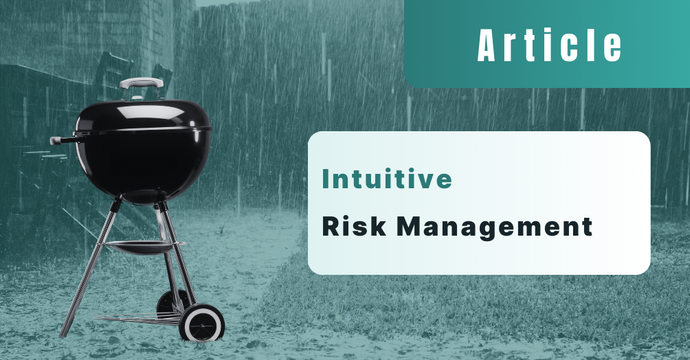Intuitive Risk Management
Ever checked the weather before a BBQ? That's risk management! In this article, I explore how our everyday decisions reflect professional Risk Management.
ARTICLE
Jan Köster
11/3/20243 min read


Ever wonder why many people shy away from risk management in projects? Often, it's because they don't know how to start and fear drowning in worst-case scenarios.
Yet, you're already doing intuitive risk management daily without even realizing it. Whether crossing the street or planning your weekend, you effectively and quickly assess risks.
In this article, I'll show you how to translate these everyday skills into a structured, professional approach for your projects. Learn to proactively manage risks and seize opportunities that you might otherwise miss.
The Weather Report
Imagine it's the weekend, and you're planning a cozy barbecue with friends and family. Sounds perfect, right? But what if clouds suddenly gather? Just like you regularly check the weather forecast to avoid being caught in a rain shower, we all use intuitive risk management methods—perhaps without even realizing it.
The Risk
Due to an approaching low-pressure area, there is a 50% chance of rain on Saturday afternoon. This could result in your planned barbecue being washed out.
Unknowingly, you have described the risk perfectly:
Due to [cause] might [risk] occur leading to [effect]
The definition of risk in project risk management is:
"A risk is a circumstance or event that can occur with a certain probability and significantly influence the outcome of a project."
The Cause
You have identified the approaching low-pressure area as the cause. Can you do anything about it? No! Are you helpless? Of course not!
So what can you 'cause-related'' now do?
Avoid: One option would be to cancel the event. However, that would be very unfortunate! What else could you do?
Mitigate: An option would be to reschedule the event to Sunday. By then, the low has passed, and the probability of rain is only 5%. This could be a solution—depending on whether all participants are available.
The Impact
If it rains, you'll get wet. The grill will get wet, the guests will get wet, the drinks will become watery, and the mood will be ruined.
What can you now do in terms of 'impact'?
Accept: Hey, a 50% chance means there's a good possibility for a dry party! And how great is a warm summer rain! It's a matter of risk appetite.
Mitigate: You could set up a pavilion (as damage limitation). At least you'd sit somewhat dry—though it's obviously not ideal.
Mitigate: You could provide extra clothing and stock up on backup drinks. (damage prevention) - It may not be the most elegant solution, but it secures the drinks.
Transfer: You could hire an event agency to organize this event and ensure it can take place in any weather. It's their job to find a solution.
Transfer: External insurance. It's said that almost everything can be insured. This may not be an appropriate measure here, but in your other projects, it could always be an option.
Is It Worth It?
All measures that positively influence the risk cost money. In our example, these are:
Reserve clothes and backup drinks
Costs for rebooking guest travel
The event agency
The pavilion
Etc.
Therefore, we must decide whether these measures to reduce the risk are worth it. This is the 'measure efficiency'.
How much is a successful party without wet guests worth to us? This question is, of course, very subjective and cannot be precisely expressed in Euros.
In projects, one can usually determine a monetary value for a risk. That's the 'risk value':
Risk value = Probability of occurrence (in %) x extent of damage (in €)
Suppose some of your guests are potential business partners who have promised contracts worth €100,000 at a successful party. If they are dissatisfied, as they have clearly told you, they will give the contracts to someone else.
The risk of doing nothing therefore corresponds to a 50% rain probability multiplied by a loss of orders of €100,000. This results in a risk value of €50,000.
You decide to reschedule the party to Sunday. You only need to buy new train tickets for the guests worth €200, since you had unfortunately booked the super saver fare.
This reduces the risk value to 5% of €100,000, i.e., €5,000. Definitely worth it!
However, there are two downsides: Even if it doesn't rain on Saturday, you still have to pay €200. If it rains on Sunday, there's still a residual risk of 5%, your business partners will not give you the contracts.
Conclusion
Risk management is not just a professional skill but a part of our everyday life. When we learn to systematically use these skills in our projects, we can not only better understand but also actively manage risks.
Make more out of your risk management!
Get your Free Blueprint
This guide will help you map out the first steps toward your new role.
It's time to 𝘁𝗿𝗮𝗻𝘀𝗳𝗼𝗿𝗺 𝗳𝗿𝗼𝗺 𝗮 𝘁𝗲𝗰𝗵𝗻𝗶𝗰𝗮𝗹 𝗲𝘅𝗽𝗲𝗿𝘁 𝗶𝗻𝘁𝗼 𝗮 𝗰𝗼𝗻𝗳𝗶𝗱𝗲𝗻𝘁 𝗹𝗲𝗮𝗱𝗲𝗿.



